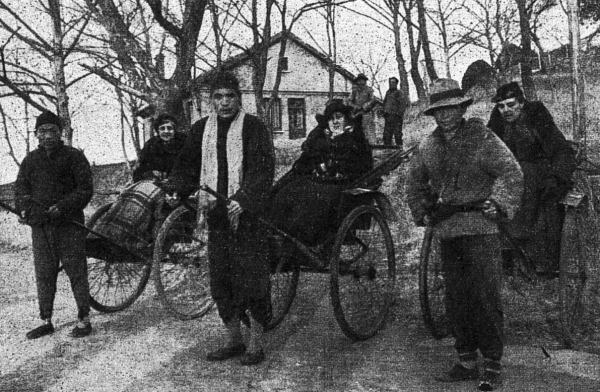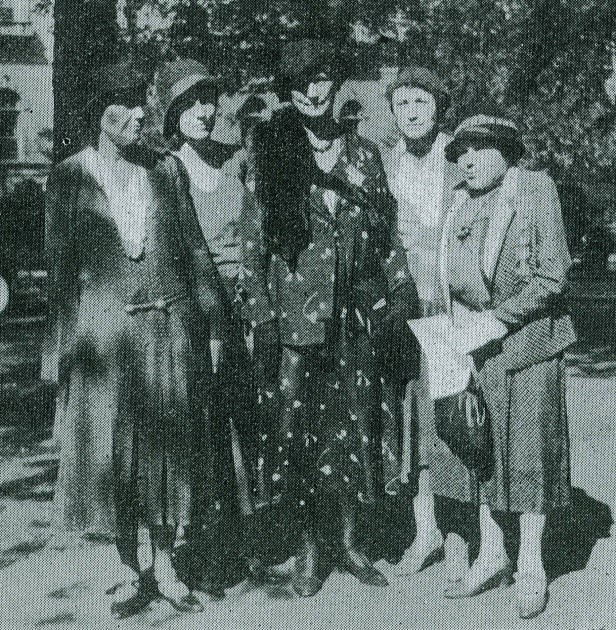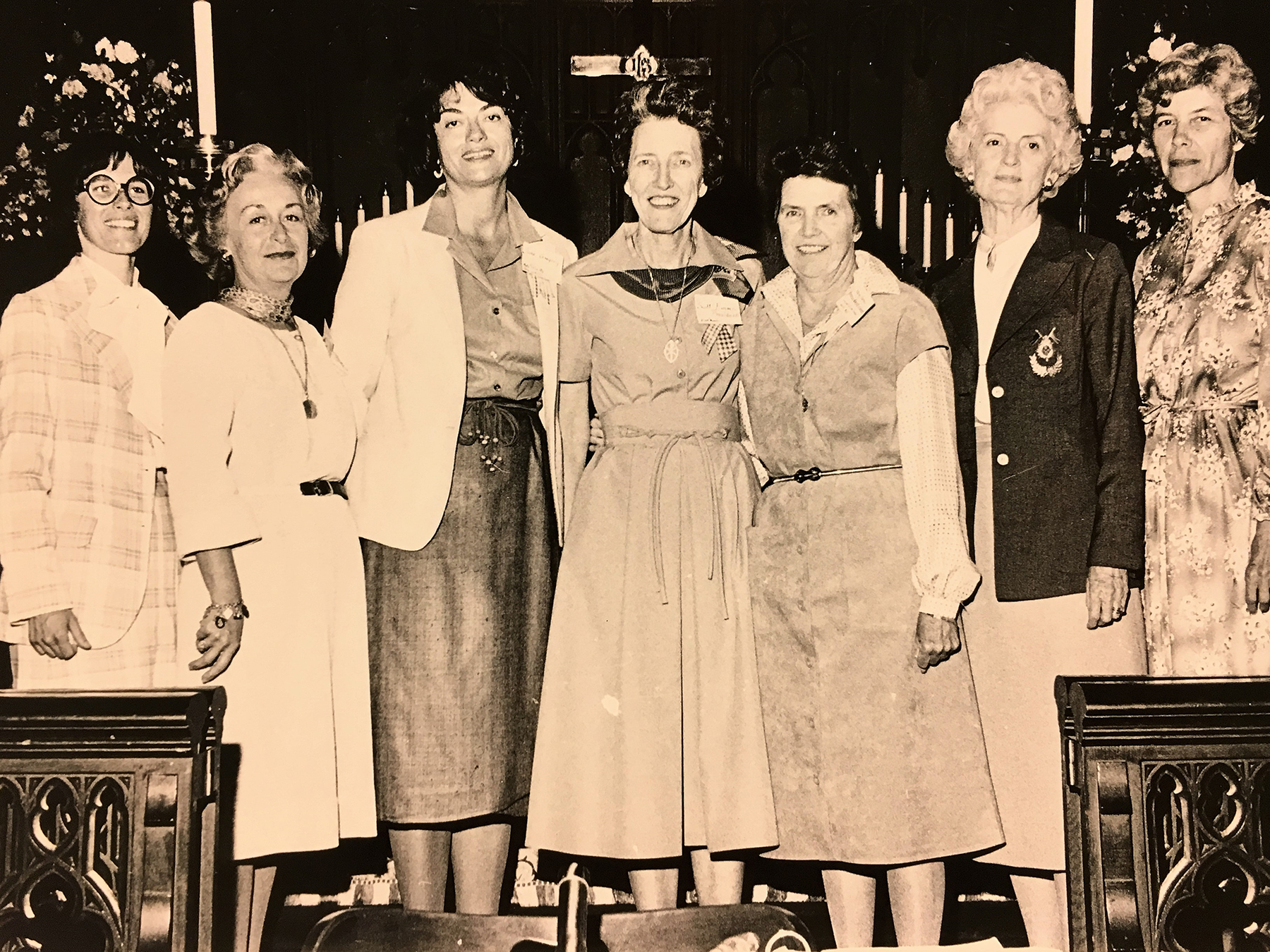Disciple: The Calling of Laywomen

Wanting to help
By Lauren Graeber
The Episcopal Church, and the Diocese of North Carolina, is deep in its reckoning of its racial history. But communities of color are not the only groups whose gifts were not immediately recognized or welcomed by the church. The contributions of laywomen have a long and storied history. Lauren Graeber, member of St. Mary’s, High Point, and graduate of the Episcopal Studies program at Wake Forest School of Divinity, uncovered some of these contributions in research conducted as part of her course work. What she found, and its effect on her own faith journey, is excerpted here; read her full paper at bit.ly/GraeberLaywomen.
It was on a theological and ethical impulse that I joined The Episcopal Church. My Episcopal Studies certificate from Wake Forest School of Divinity was always about me grappling with that choice, evaluating the church to see if I could make it my home. In my coursework, I was particularly taken with laywomen.
[Image: Laura Clark of Scotland Neck (left) and two companions in China. The North Carolina Churchman, September 1, 1936]
Across the history of The Episcopal Church, laywomen have been key to its growth and vitality. Where to start and end an account of their inclusion in and recognition by the church? The movement for women to be seated in the House of Deputies? Although that’s a convenient frame for a piece of the story, it is not broad enough to include how the Women’s Auxiliary formalized and structured the time, presence and efforts of laywomen long before 1919, when the question of official recognition seemed first most promising and most dashed; how they continued to persevere from 1946-1964, when every General Convention rejected a reinterpretation of “laymen” to include women; nor does it encompass the continued work of laywomen since they were seated in 1970.
Neither is that frame flexible enough to account for the ways that laywomen were instrumental in the movement for women’s ordination. Finally, allowing the seating of women in the House of Deputies in 1970 to be a neat conclusion to the story risks closing down what ought to be an ongoing, critical self-assessment among all Episcopalians about how the inclusion of women remains unfinished business.
In our current context, distinctions appear easier given that women can be and have been ordained. But when no woman could be ordained, women were still acting as ministers in the service of The Episcopal Church in roles now filled by contemporary female priests, deacons and bishops. They were the female missionaries, nuns and principals of Episcopal schools—none of whom were ordained but whose work sure looks similar to that of ordained women today. [1]
Then whose story am I telling when I write about laywomen? Most simply, a whole host of generous and powerful women. Women who served in their branches of the auxiliary, in their guilds and, eventually, their vestries. Women who gave sacrificially of their time and money. Women who gathered at the Triennial Meetings. Women who now sit at diocesan and general conventions. Women who show up at every Episcopal Church Women (ECW) event. These are women whose lives were not officially set apart by the church and yet whose willingness to serve was in no way diminished by that fact.
“DO WHAT YOU CAN”
Formed in 1872 as the Women’s Association, Auxiliary to the Board of Missions, with Mary Abbot Emery as its first General Secretary, the Women’s Auxiliary of The Episcopal Church worked for the next century to provide structure and support for Episcopal women’s work. [2] Emery wrote to her fellow churchwomen in an early auxiliary publication, “Do what you can, and do it in just the way best suited to your individual tastes, to the circumstances of your parish, to the state of life in which God has placed you.” [3] Her sentiment, her leadership, and that of her sister, Julia Emery, who followed her, is about faithfully working, assuming God has a call on your life. It is also about working within the institution as it is, accepting it as it is. Mary Donovan notes, “In the period between 1850 and 1919, women developed a wide range of ministries, and yet neither they nor the Church recognized their work as ministry.” [4]
The first North Carolina branch of the Women’s Auxiliary was constituted in 1835, and the women of North Carolina began an unbroken history of devoted service as fundraisers, hosts, caretakers of the church and services, social advocates and faithful members. These were very busy people. Yet they were considered second-class citizens in the eyes of the church, reflected in Donovan’s description:
Symbolically, the women were viewed as handmaidens, as those who prepared the way for the priests, the Church’s authentic ministers. In local parishes they served as the altar guild—those who could set the table but not serve the meal. They instructed children in the fundamentals of the Christian faith but were not allowed to present those children to the bishop for confirmation. [6]
So why did they stay? Why did they do it?
RESPONDING TO GOD’S CALLING

That answer is complicated. Zoom out to a theoretical macro-level and you get Margaret Miles’ answer that “[t]he gratification to be earned from progressively learning how to engage, control and reap the rewards of the social order are inextricably linked to women’s self-insertion into society.” [7] Women maximized their roles within the institution and navigated that work in ways that utilized the institution to women’s benefit. That navigation, in and of itself, required strategy and creativity.
Donovan offers an alternative answer for why other kinds of laywomen stayed with The Episcopal Church. Writing about women who served as missionaries, educators, deaconesses and social activists, she says, “they thought of themselves as full members of the Church, as people called to proclaim Christ’s saving love to all the world. That call was empowering; it enabled them to scorn custom, to develop new ministries, to forge unusual lifestyles for themselves and their sisters.” [8]
[Image: Delegates to 1931 Triennial in Denver.]
This is borne out in the stories of laywomen in North Carolina. In “Miss Hall’s Monthly Letter” in the 1934 diocesan publication, “The Carolina Churchman,” Hall joyfully recounts a recent visit by women from the diocese serving as missionaries. They include “Miss Mary Wood McKenzie, our own missionary to Liberia, and Miss Bessie Blacknall, who also is one of North Carolina’s daughters in Alaska” as well as “Miss Laura Clark, of Scotland Neck, [who was] to be the secretary to the…Bishop of Anking” in Shanghai. [9] It was 1934, and North Carolina Episcopal women were traveling the world as missionaries!
Twenty years later (and still almost 20 years before their seating as lay deputies), in an annual report to the Women’s Auxiliary, the North Carolina women noted their continued desire to recruit “more women workers in the church.” [10] They hoped to find “College Workers, Directors of Religious Education, Parish Secretaries, Social Workers, Teachers, Nurses and Missionaries.” [11] Nowhere in their records did they lament that the church limited their official inclusion. They responded to their sense of God’s calling.
I do not mean to suggest that women unconsciously accepted diminished membership in The Episcopal Church or that they did not actively petition and advocate for equal membership. All the gains that women made within the institution were driven by their own efforts. Kujawa-Holbrook summarized the story of Episcopal women this way: “She quietly, and with great dignity, persisted under difficult circumstances, until she prevailed. This pattern captures women’s vocation in the Church; the dignity, the persistence, and the refusal to go away.” [12]

Some of the earliest forceful petitioning by women of the church came from the Companions of the Holy Cross, a society formed by and for laywomen. Among their important work in terms of expanding the voice for women was their direct petitioning of the General Convention on social justice matters. They sent a proposal to the 1907 General Convention calling on the church to address social and labor ills, a petition that successfully passed and led to the reappointment of what would become the Joint Commission on Social Service both in 1907 and again in 1910, a commission that included women members. [13] In 1916, the companions petitioned the General Convention again, this time to address worker welfare, income inequality and the church’s obligation to be a witness and advocate in these areas. [14] In taking these steps, the companions were pushing at the edges of acceptable behaviors for women within the institution and demonstrating women’s desire for and ability to participate at the national level of church governance.
[Image: 1979 installation of ECW officers. The Communicant, May 1979]
While the 1919 General Convention’s defeat of the suffrage resolution showed what Donovan names as women’s “marginal position in the Church,” [15] women quietly but persistently continued to push the church for expanded leadership opportunities. One area in which this work continued was at the level of parish vestries. The Diocese of North Carolina was roiled in 1935 by the election of women onto the vestry of St. Savior’s, Raleigh. As St. Savior’s reported in “The Carolina Churchman:”
On January 15th, we held our annual meeting of the congregation. The reports showed that very fine work had been done all along the line during the year. The congregation voted to do something a bit unusual—elect women on the Vestry. Some of us rather shook our heads a bit but we are willing to try some things at least once. [16]
The decision was not roundly celebrated; other parishes were vocal in their condemnation, pointing to the then-canons of the diocese to prove that it was only baptized male members of a parish that should have been allowed on vestry. [17]
Nationwide, the election of women to vestries began in earnest in the 1950s and was driven, as the North Carolina example shows, by individual congregations, and primarily by women within them. As Donovan writes, “Once women realized they would always be second-class citizens in an institution that limited its priesthood to men, they were able to confront the church with its own claim of the equality of all people before God.” [18] The persistence of Episcopal women in petitioning the church on their own behalf throughout the 20th century showed that no official vote or change of canon could deter them.
Yet the ambivalence Episcopal women felt about their changing position within the church is captured in the memories of Scott Evans Hughes. As she reflected on her experience of being a direct witness and participant in the changing roles for women, she says it was “lonely, and the voice in the wilderness a lot of times. I felt that I was tokenly accepted, and I was never sure how much weight my remarks made. It was nothing overt. It was just the feeling that one had of, you were being, quote, ‘tolerated.’” [19] Yet, she faithfully persisted. [20] Like so many other laywomen, she set aside frustration and setbacks and insisted on doing the work anyway.
Researching laywomen leads to a stream of women whose mostly quiet contributions to their church offer a narrative of what faithfulness across a lifetime can mean. They were quick and responsive; they wanted to help, and they didn’t insist that the work or their role in it had to be monumental, even when it was.
LEARN MORE
Read more stories of Episcopal Women in the Diocese of North Carolina in “By Pen or By Prose: Churchwomen Make Their Mark.”
Lauren Graeber is a member of St. Mary’s, High Point, and a graduate of the Episcopal Studies program at Wake Forest School of Divinity. Contact her via the communications department.
[2] Pamela W. Darling, New Wine: The Story of Women Transforming Leadership and Power in the Episcopal Church (Cambridge, Mass: Cowley Publications, 1994), 18.
[3] qtd in Darling, 19.
[4] Donovan, Mary Sudman, A Different Call: Women’s Ministries in the Episcopal Church, 1850-1920 (Wilton, Conn: Morehouse-Barlow, 1986), 174.
[5] Hoke, Lynn, Laywomen of the Diocese of NC, Phone, November 6, 2018.
[6] Donovan, 174.
[7] Miles, Margaret R, “Theory, Theology, and Episcopal Churchwomen,” in Episcopal Women: Gender, Spirituality, and Commitment in an American Mainline Denomination, ed. Prelinger, Catherine M. (New York: Oxford University Press, 1992), 333.
[8] Donovan,170.
[9] qtd. in “Quotes - Cumulative-Chronological” (Archives of the NC Diocese of the Episcopal Church, n.d.), 86.
[10] qtd. in “Quotes - Cumulative-Chronological,” 98.
[11] Ibid
[12] Kujawa-Holbrook, Sheryl A., “Women and Vocation in the Episcopal Church: Reflections on Our History,” 104.
[13] Donovan, Mary Sudman, 151-152.
[14] Ibid., 152.
[15] Ibid., 171.
[16] qtd. in “Quotes - Cumulative-Chronological,” 88.
[17] Ibid.
[18] Donovan, 174.
[19] Ibid., 9.
[20] from Hoke, Lynn, “Additional Documents.”
